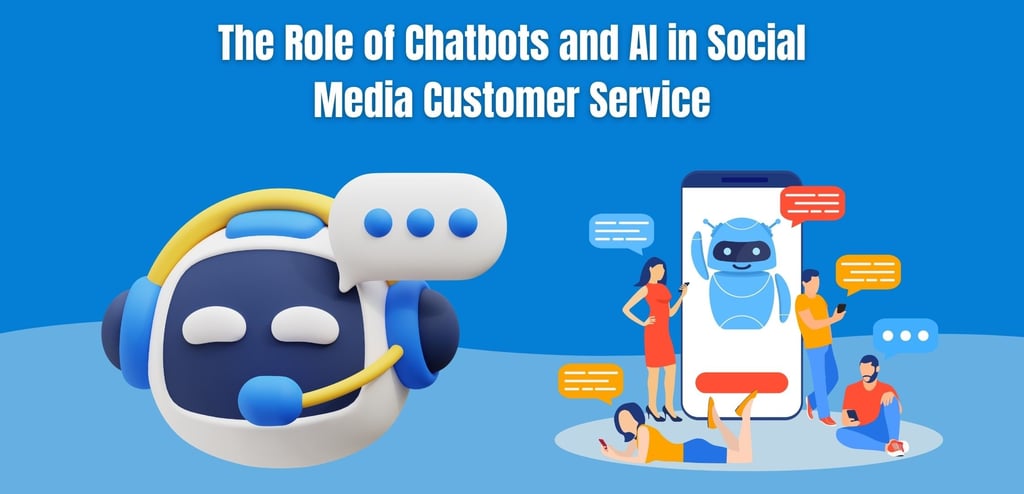
The Role of Chatbots and AI in Social Media Customer Service
By AZ Konnect Team
12/12/20246 min read


In the ever-evolving world of social media, businesses are increasingly looking for ways to improve customer service and engagement. One of the most transformative solutions in recent years has been the integration of chatbots and artificial intelligence (AI). These technologies are reshaping how companies interact with their customers on platforms like Facebook, Instagram, Twitter, and others. From offering instant responses to providing personalized experiences, chatbots and AI are revolutionizing social media customer service, making it faster, more efficient, and available 24/7.
In this blog post, we'll explore how chatbots and AI are playing a pivotal role in social media customer service, the benefits they offer, and the challenges businesses need to be aware of when implementing these technologies.
1. The Rise of Chatbots in Social Media Customer Service
As social media platforms have become a primary touchpoint for customer interactions, businesses are turning to chatbots to handle the increasing volume of inquiries, comments, and support requests. Chatbots are automated tools that simulate human conversation and can respond to customers in real-time. They’re typically programmed with specific scripts or, in more advanced cases, powered by machine learning algorithms that allow them to adapt and improve over time.
Key Use Cases for Chatbots in Social Media:
Instant Responses to Frequently Asked Questions (FAQs):
Chatbots can instantly answer common questions like business hours, product availability, or return policies. This frees up human agents to focus on more complex tasks while ensuring that customers get immediate answers.
Handling High Volumes of Customer Inquiries:
During busy periods like sales or product launches, chatbots can manage large volumes of messages and comments, preventing customer frustration due to delayed responses.
24/7 Customer Support:
Unlike human agents, chatbots can operate around the clock, providing customers with support at any time, no matter the time zone or hour of the day.
Lead Generation and Sales Support:
Chatbots can engage potential customers by asking qualifying questions, recommending products, and even facilitating purchases directly through social media platforms.
2. How AI Enhances Chatbot Functionality
While traditional chatbots are based on predefined scripts, AI-powered chatbots take customer service to the next level. With AI, chatbots become more intelligent and can handle a wider range of tasks, including processing natural language, learning from customer interactions, and even detecting customer sentiment.
Key AI Capabilities in Social Media Chatbots:
Natural Language Processing (NLP):
AI-driven chatbots can understand and interpret human language more accurately, allowing them to respond in a conversational, human-like manner. NLP enables chatbots to comprehend various phrases, slang, and even misspellings, making interactions more seamless and less robotic.
Sentiment Analysis:
AI can analyze customer sentiment by detecting emotions in messages—whether a customer is frustrated, happy, or neutral. By recognizing the tone of the conversation, the chatbot can adjust its responses accordingly or escalate the issue to a human agent if needed.
Learning from Interactions:
Machine learning allows AI-powered chatbots to improve over time by learning from each interaction. The more customers engage with the bot, the better it becomes at providing accurate, relevant responses.
Personalization:
AI enables chatbots to deliver personalized experiences by analyzing customer data and behavior. For example, a chatbot can recommend products based on a customer’s purchase history, previous interactions, or browsing habits.
3. Benefits of Using Chatbots and AI for Social Media Customer Service
The adoption of chatbots and AI in social media customer service offers a wide range of benefits for both businesses and customers. By automating routine tasks and improving response times, companies can enhance customer satisfaction while reducing the strain on human support teams.
Benefits for Businesses:
Cost-Effectiveness:
Implementing chatbots can significantly reduce the cost of customer service by minimizing the need for large teams of human agents, especially for handling simple inquiries. Bots can scale to manage thousands of conversations simultaneously, reducing the need for additional staff during peak times.
Faster Response Times:
With chatbots, customers no longer have to wait in long queues for responses. Instant replies mean customers get the information they need immediately, improving satisfaction and trust.
Consistency:
Chatbots provide consistent answers every time, reducing the risk of miscommunication or errors that can occur with human agents. This consistency helps maintain a high standard of service across all customer interactions.
Improved Scalability:
As businesses grow, so does the volume of customer inquiries. Chatbots and AI can easily scale to handle increased demand, ensuring that customer service doesn’t suffer as the company expands.
Benefits for Customers:
Instant Access to Support:
Chatbots make it easy for customers to access help without waiting or navigating through complex menus. Whether they’re looking for quick answers or support during a purchase, bots provide instant, frictionless assistance.
24/7 Availability:
Customers can interact with chatbots at any time, meaning they don’t have to rely on traditional business hours to get help. This is especially beneficial for global businesses with customers in different time zones.
Seamless Social Media Integration:
Since chatbots operate within social media platforms, customers don’t have to leave the platform to seek support. This creates a more convenient experience, allowing them to engage with the brand directly where they already spend time.
Personalized Interactions:
With AI, customers can receive personalized recommendations and support, making their experience more relevant to their needs. Personalization enhances the overall customer journey, turning one-time buyers into repeat customers.
4. Challenges of Implementing Chatbots and AI in Social Media Customer Service
While chatbots and AI offer significant advantages, they also come with certain challenges that businesses need to address to ensure a smooth customer experience.
1. Limitations in Handling Complex Queries
Chatbots excel at handling simple, repetitive inquiries, but they can struggle with more complex or nuanced issues. If a customer’s question goes beyond the chatbot’s programmed capabilities, there’s a risk of providing an unsatisfactory response, which can lead to frustration. This is why it’s essential to integrate escalation paths that allow bots to hand over difficult queries to human agents seamlessly.
2. Personalization Requires Data
AI-powered chatbots rely on customer data to deliver personalized experiences. However, gathering and utilizing this data effectively can be challenging, especially with increasing concerns over data privacy and regulations like GDPR. Businesses must ensure they are transparent with customers about how their data is used and take measures to protect it.
3. Bot Fatigue
While chatbots can significantly improve response times, customers sometimes grow tired of interacting with automated systems, particularly if the conversation feels too robotic or repetitive. It's crucial to design chatbot interactions that feel human-like and natural while also offering the option to speak with a live agent when needed.
4. Implementation and Maintenance
Setting up AI-powered chatbots requires time, resources, and technical expertise. Businesses need to invest in the right technology and ensure that their bots are properly maintained and updated to handle evolving customer needs and emerging trends in natural language processing.
5. Best Practices for Using Chatbots and AI in Social Media Customer Service
To make the most of chatbots and AI, businesses should follow best practices that focus on enhancing the customer experience and ensuring smooth, efficient interactions.
1. Define Clear Bot Capabilities
When implementing a chatbot, clearly define what it can and cannot do. Customers should know when they are speaking to a bot and when they might need to be transferred to a human agent. Providing transparency helps manage customer expectations and prevents frustration.
2. Prioritize User Experience
The design of your chatbot’s conversational flow should prioritize ease of use and intuitiveness. Keep interactions simple, concise, and goal-oriented. The less effort it takes for customers to get the information they need, the better their experience will be.
3. Monitor and Optimize Regularly
Regularly review the performance of your chatbot and use data to improve its functionality. Analyze user feedback, success rates, and common failure points to fine-tune the bot’s responses and expand its capabilities over time.
4. Seamless Human Escalation
Ensure that there’s an easy path for customers to escalate their issue to a human agent if needed. If a bot cannot solve a problem, it should transfer the conversation to a live support agent without requiring the customer to repeat their inquiry. This maintains a smooth, cohesive experience.
Conclusion
Chatbots and AI are transforming the way businesses approach social media customer service by offering faster, more scalable, and personalized solutions. As consumers continue to expect instant responses and seamless support, these technologies are becoming essential tools for companies looking to enhance their social media presence and customer engagement. However, while chatbots and AI offer significant advantages, businesses must carefully consider their implementation to ensure they provide a positive and effective customer experience.
By combining AI’s intelligence with the responsiveness of chatbots, companies can create a customer service system that meets the growing demands of today’s digital consumers—driving satisfaction, loyalty, and ultimately, business success.
Subscribe To Our Newsletter


